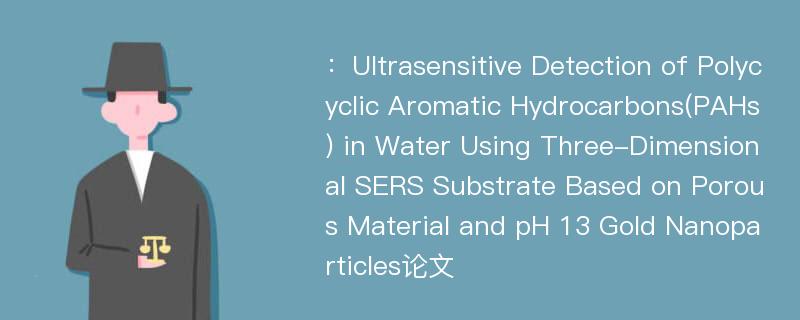
本文主要研究内容
作者(2019)在《Ultrasensitive Detection of Polycyclic Aromatic Hydrocarbons(PAHs) in Water Using Three-Dimensional SERS Substrate Based on Porous Material and pH 13 Gold Nanoparticles》一文中研究指出:Sensitivity is crucially important for surface-enhanced Raman spectroscopy(SERS) application to detect trace-level polycyclic aromatic hydrocarbons(PAHs) in the seawater. In this study, a high sensitivity three-dimensional(3-D) SERS substrate composed with syringe filter, glycidyl methacrylate-ethylene dimethacrylate(GMA-EDMA) porous material and optimal parameters(57 nm, pH 13) gold nanoparticles(Au NPs) was developed for the detection of PAHs in water. The enhancement effect and repeatability of this 3-D substrate were also explored. The Raman intensity of pyrene using 3-D SERS substrate is about 8 times higher than that of substrate only using p H 13 gold colloid solution and about 12 times higher than that of substrate using natural Au NPs and GMA-EDMA porous material, which means both the pH 13 AuN Ps and the GMA-EDMA porous material are important factors for the sensitivity of this 3-D SERS substrate. Good repeatability of this optimal 3-D substrate was obtained. The relative standard deviation(RSD) is less than 8.66% on the same substrate and less than 3.69% on other different substrates. Four kinds of PAHs, i.e., phenanthrene, pyrene, benzo(a)pyrene, benzo(k)fluoranthene and their mixture, were detected at the different concentrations. Their limits of detection(LODs) are 8.3×10-10(phenanthrene), 2.1×10-10(pyrene), 3.8×10-10(benzo(a)pyrene) and 1.7×10-10 mol L-1(benzo(k)fluoranthene), respectively. In addition, these four PAHs were also detected by fluorescence spectroscopy to evaluate the sensitivity of SERS technology using this optimal 3-D SERS substrate. The results showed that the sensitivity of SERS based on the 3-D SERS substrate even using the portable Raman system was closed to that of fluorescence spectroscopy. Therefore, the SERS technology using this optimal 3-D substrate is expected to be an in-situ method for the detection of environmental PAHs.
Abstract
Sensitivity is crucially important for surface-enhanced Raman spectroscopy(SERS) application to detect trace-level polycyclic aromatic hydrocarbons(PAHs) in the seawater. In this study, a high sensitivity three-dimensional(3-D) SERS substrate composed with syringe filter, glycidyl methacrylate-ethylene dimethacrylate(GMA-EDMA) porous material and optimal parameters(57 nm, pH 13) gold nanoparticles(Au NPs) was developed for the detection of PAHs in water. The enhancement effect and repeatability of this 3-D substrate were also explored. The Raman intensity of pyrene using 3-D SERS substrate is about 8 times higher than that of substrate only using p H 13 gold colloid solution and about 12 times higher than that of substrate using natural Au NPs and GMA-EDMA porous material, which means both the pH 13 AuN Ps and the GMA-EDMA porous material are important factors for the sensitivity of this 3-D SERS substrate. Good repeatability of this optimal 3-D substrate was obtained. The relative standard deviation(RSD) is less than 8.66% on the same substrate and less than 3.69% on other different substrates. Four kinds of PAHs, i.e., phenanthrene, pyrene, benzo(a)pyrene, benzo(k)fluoranthene and their mixture, were detected at the different concentrations. Their limits of detection(LODs) are 8.3×10-10(phenanthrene), 2.1×10-10(pyrene), 3.8×10-10(benzo(a)pyrene) and 1.7×10-10 mol L-1(benzo(k)fluoranthene), respectively. In addition, these four PAHs were also detected by fluorescence spectroscopy to evaluate the sensitivity of SERS technology using this optimal 3-D SERS substrate. The results showed that the sensitivity of SERS based on the 3-D SERS substrate even using the portable Raman system was closed to that of fluorescence spectroscopy. Therefore, the SERS technology using this optimal 3-D substrate is expected to be an in-situ method for the detection of environmental PAHs.
论文参考文献
论文详细介绍
论文作者分别是来自Journal of Ocean University of China的,发表于刊物Journal of Ocean University of China2019年06期论文,是一篇关于,Journal of Ocean University of China2019年06期论文的文章。本文可供学术参考使用,各位学者可以免费参考阅读下载,文章观点不代表本站观点,资料来自Journal of Ocean University of China2019年06期论文网站,若本站收录的文献无意侵犯了您的著作版权,请联系我们删除。
